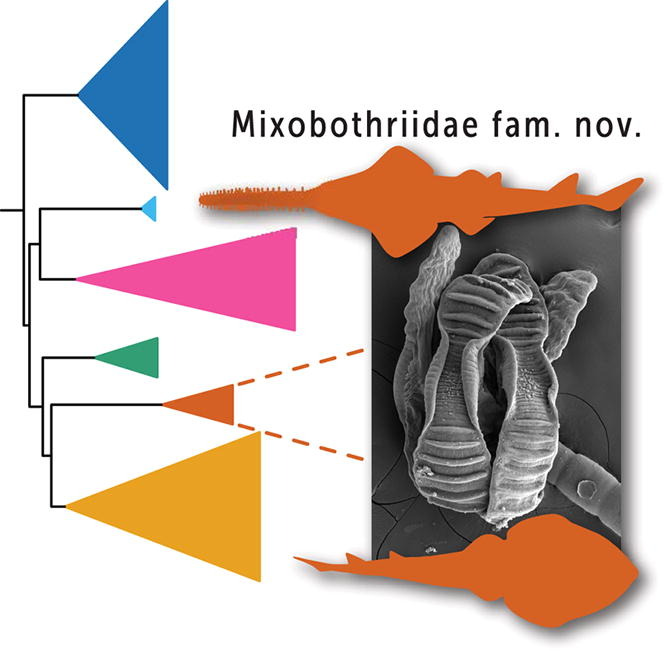Two new publications on parasites, with vouchers in the BRC!
 Herzog, K.S., J.N. Caira, P.Kumar Kar & K. Jensen. 2023. Novelty and phylogenetic affinities of a new family of tapeworms (Cestoda: Rhinebothriidea) from endangered sawfish and guitarfish. International Journal for Parasitology 53: 347–362. pdf
Herzog, K.S., J.N. Caira, P.Kumar Kar & K. Jensen. 2023. Novelty and phylogenetic affinities of a new family of tapeworms (Cestoda: Rhinebothriidea) from endangered sawfish and guitarfish. International Journal for Parasitology 53: 347–362. pdf
Abstract reads: The parasites of hosts of conservation concern are often poorly known. This is the case with the iconic group of elasmobranchs known as the sawfish of the genus Pristis, all four species of which are considered as Endangered or Critically Endangered by the International Union for Conservation of Nature (IUCN, Switzerland). Examination of cestodes from three species of sawfish (Pristis pristis, Pristis clavata, and Pristis zijsron) in Australia and one of their close relatives, the also critically endangered widenose guitarfish, Glaucostegus obtusus, in India, collected over the past 25 years, yielded four new species of tapeworms which are described herein. All four belong to the previously monotypic Mixobothrium; the diagnosis of the genus is revised to accommodate the new species. Among the new taxa is a species that had been included in previous molecular phylogenies but whose identity and affinities within the order Rhinebothriidea, and thus also its familial placement, were unclear. This species exhibits the morphological features of Mixobothrium and thus its identity is, at long last, revealed. Sequence data generated for the 28S rDNA gene for three of the new species, as well as an additional new but yet undescribed species from Pristis pectinata from Florida (USA), confirms the uniqueness of this group among the rhinebothriideans. The new family Mixobothriidae is established to house these taxa. The members of this family differ from all but one of the five other families of rhinebothriideans in lacking apical suckers on their bothridia. They are also distinctive in that their bothridia are divided into three regions. The anterior and posterior regions have similar locular configurations to one another and differ from the locular configuration of the middle region. As a consequence, the bothridia are symmetrical along both their vertical and horizontal axes. We predict that a focus on species of guitarfish in the genus Glaucostegus will be the most productive approach for discovering additional diversity in this family of cestodes.
Bueno, V.M. & J.N. Caira. 2023. Phylogenetic relationships. host associations, and three new species of a poorly known group of “tetraphyllidean” tapeworms from elasmobranchs. Zootaxa 5254: 030–050. pdf
Abstract reads: This paper aims to expand understanding of a poorly known group of cestodes that parasitize an intriguingly diverse suite of elasmobranchs. The group’s three currently described members (i.e., Pentaloculum macrocephalum, Pentaloculum hoi, and Zyxibothrium kamienae) parasitize an electric ray, a carpet shark, and a skate, respectively. Pentaloculum grahami n. sp. is described from a second genus of carpet shark, specifically Parascyllium collare, in Australia. Zyxibothrium duffyi n. sp. and Zyxibothrium healyae n. sp. are described from the deep-sea skates Brochiraja asperula and Brochiraja spinifera, respectively off New Zealand. The three new species share distinctive bothridia that bear a small number of large, circular, facial loculi and lateral bands of vitelline follicles that converge posterior to the ovary—features which are found in all other members of these genera. Zyxibothrium healyae n. sp. is unique in possessing three, rather than four or five, facial loculi. Zyxibothrium duffyi n. sp. possesses a combination of five facial loculi and vitelline follicles that stop short of the anterior margin of the proglottid. Pentaloculum grahami n. sp. is the largest member of the group with the greatest number of proglottids. Based on striking similarities in scolex morphology, Pentaloculum and Zyxibothrium have been hypothesized to belong to a distinct subgroup of “tetraphyllideans” provisionally designated as Clade 1. Based on sequence data for the D1–D3 region of the 28S rDNA gene generated for species of Zyxibothrium for the first time, we confirm the reciprocal monophyly of both genera as well as the monophyly of Clade 1 and its status as a distinct lineage among the “Tetraphyllidea”. This work also suggests that the presence of five facial loculi is homoplasious given this character state is found in members of both genera. The new species expand the host associations of Clade 1 to include additional skate and carpet shark genera. Moving forward we would expect to find additional members of this group parasitizing other species of parascyliid carpet sharks as well as other species of the rajid genus Malacoraja and the arhynchobatid genus Brochiraja. Here we have doubled the number of described species in the taxon referred to as Clade 1 while simultaneously expanding our understanding of the morphology and anatomy of its members. This additional information will help inform the ultimate revision of the ordinal classification of the cestodes to address the highly polyphyletic nature of the order “Tetraphyllidea” as it is currently configured.